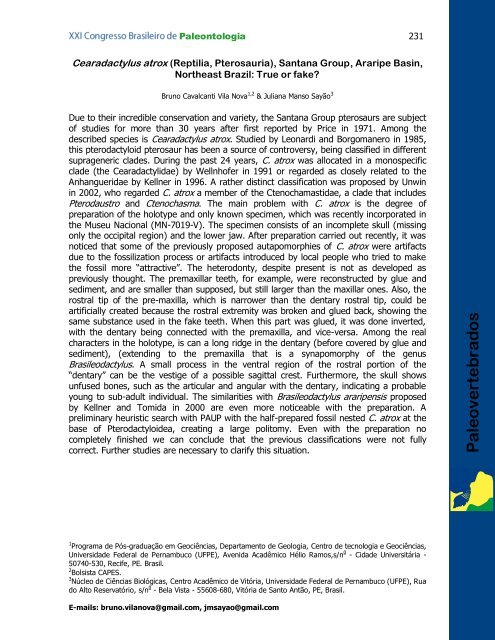Livro de Resumos - Dinossauros do Maranhão
Livro de Resumos - Dinossauros do Maranhão
Livro de Resumos - Dinossauros do Maranhão
Create successful ePaper yourself
Turn your PDF publications into a flip-book with our unique Google optimized e-Paper software.
Paleontologia 231<br />
Cearadactylus atrox (Reptilia, Pterosauria), Santana Group, Araripe Basin,<br />
Northeast Brazil: True or fake?<br />
Bruno Cavalcanti Vila Nova 1,2 & Juliana Manso Sayão 3<br />
Due to their incredible conservation and variety, the Santana Group pterosaurs are subject<br />
of studies for more than 30 years after first reported by Price in 1971. Among the<br />
<strong>de</strong>scribed species is Cearadactylus atrox. Studied by Leonardi and Borgomanero in 1985,<br />
this pterodactyloid pterosaur has been a source of controversy, being classified in different<br />
suprageneric cla<strong>de</strong>s. During the past 24 years, C. atrox was allocated in a monospecific<br />
cla<strong>de</strong> (the Cearadactylidae) by Wellnhofer in 1991 or regar<strong>de</strong>d as closely related to the<br />
Anhangueridae by Kellner in 1996. A rather distinct classification was proposed by Unwin<br />
in 2002, who regar<strong>de</strong>d C. atrox a member of the Ctenochamastidae, a cla<strong>de</strong> that inclu<strong>de</strong>s<br />
Pterodaustro and Ctenochasma. The main problem with C. atrox is the <strong>de</strong>gree of<br />
preparation of the holotype and only known specimen, which was recently incorporated in<br />
the Museu Nacional (MN-7019-V). The specimen consists of an incomplete skull (missing<br />
only the occipital region) and the lower jaw. After preparation carried out recently, it was<br />
noticed that some of the previously proposed autapomorphies of C. atrox were artifacts<br />
due to the fossilization process or artifacts introduced by local people who tried to make<br />
the fossil more “attractive”. The hetero<strong>do</strong>nty, <strong>de</strong>spite present is not as <strong>de</strong>veloped as<br />
previously thought. The premaxillar teeth, for example, were reconstructed by glue and<br />
sediment, and are smaller than supposed, but still larger than the maxillar ones. Also, the<br />
rostral tip of the pre-maxilla, which is narrower than the <strong>de</strong>ntary rostral tip, could be<br />
artificially created because the rostral extremity was broken and glued back, showing the<br />
same substance used in the fake teeth. When this part was glued, it was <strong>do</strong>ne inverted,<br />
with the <strong>de</strong>ntary being connected with the premaxilla, and vice-versa. Among the real<br />
characters in the holotype, is can a long ridge in the <strong>de</strong>ntary (before covered by glue and<br />
sediment), (extending to the premaxilla that is a synapomorphy of the genus<br />
Brasileodactylus. A small process in the ventral region of the rostral portion of the<br />
“<strong>de</strong>ntary” can be the vestige of a possible sagittal crest. Furthermore, the skull shows<br />
unfused bones, such as the articular and angular with the <strong>de</strong>ntary, indicating a probable<br />
young to sub-adult individual. The similarities with Brasileodactylus araripensis proposed<br />
by Kellner and Tomida in 2000 are even more noticeable with the preparation. A<br />
preliminary heuristic search with PAUP with the half-prepared fossil nested C. atrox at the<br />
base of Pterodactyloi<strong>de</strong>a, creating a large politomy. Even with the preparation no<br />
completely finished we can conclu<strong>de</strong> that the previous classifications were not fully<br />
correct. Further studies are necessary to clarify this situation.<br />
1 Programa <strong>de</strong> Pós-graduação em Geociências, Departamento <strong>de</strong> Geologia, Centro <strong>de</strong> tecnologia e Geociências,<br />
Universida<strong>de</strong> Fe<strong>de</strong>ral <strong>de</strong> Pernambuco (UFPE), Avenida Acadêmico Hélio Ramos,s/n 0 - Cida<strong>de</strong> Universitária -<br />
50740-530, Recife, PE. Brasil.<br />
2 Bolsista CAPES.<br />
3 Núcleo <strong>de</strong> Ciências Biológicas, Centro Acadêmico <strong>de</strong> Vitória, Universida<strong>de</strong> Fe<strong>de</strong>ral <strong>de</strong> Pernambuco (UFPE), Rua<br />
<strong>do</strong> Alto Reservatório, s/n 0 - Bela Vista - 55608-680, Vitória <strong>de</strong> Santo Antão, PE, Brasil.<br />
E-mails: bruno.vilanova@gmail.com, jmsayao@gmail.com<br />
Paleovertebra<strong>do</strong>s


